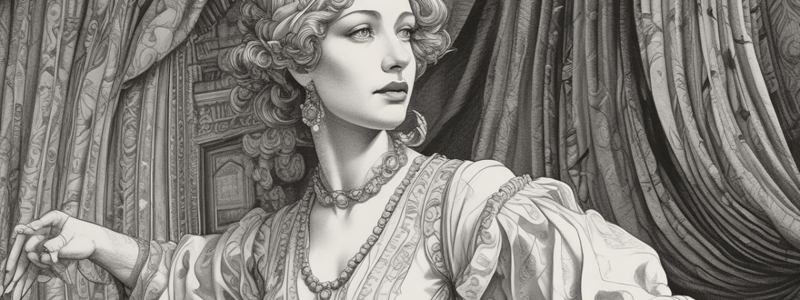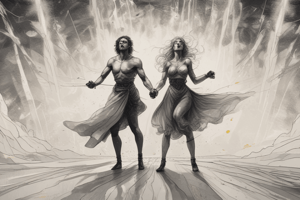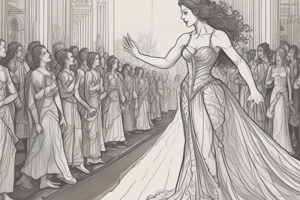Podcast
Questions and Answers
Which of the following is a characteristic of Theatre of the Absurd?
Which of the following is a characteristic of Theatre of the Absurd?
- Optimistic outlook on human existence
- Focus on the significance of life
- Use of realistic dialogue
- Portrayal of mundane activities in a ritualistic manner (correct)
What is the main theme explored in Samuel Beckett's Waiting for Godot?
What is the main theme explored in Samuel Beckett's Waiting for Godot?
- The importance of social conventions
- The beauty of nature
- The power of friendship
- The uncertainty of life (correct)
Which playwright is known for his work The Bald Soprano?
Which playwright is known for his work The Bald Soprano?
- Eugene Ionesco (correct)
- Samuel Beckett
- Harold Pinter
- Jean Genet
What is the primary goal of method acting?
What is the primary goal of method acting?
What is the term for recalling personal experiences and emotions to portray a character authentically?
What is the term for recalling personal experiences and emotions to portray a character authentically?
What is the name of the system developed by Constantin Stanislavski?
What is the name of the system developed by Constantin Stanislavski?
What is the main purpose of sense memory in method acting?
What is the main purpose of sense memory in method acting?
Which play by Harold Pinter explores themes of memory, identity, and power dynamics?
Which play by Harold Pinter explores themes of memory, identity, and power dynamics?
What is the term for thoroughly analyzing the character's background, motivations, and objectives?
What is the term for thoroughly analyzing the character's background, motivations, and objectives?
Which playwright is known for his work The Balcony?
Which playwright is known for his work The Balcony?
What is the primary focus of Stanislavski's System?
What is the primary focus of Stanislavski's System?
What is the purpose of Brechtian Theatre's alienation effect?
What is the purpose of Brechtian Theatre's alienation effect?
Which technique emphasizes the body as the primary vehicle for performance?
Which technique emphasizes the body as the primary vehicle for performance?
What is a key concept in Stanislavski's System?
What is a key concept in Stanislavski's System?
Who is the developer of Brechtian Theatre?
Who is the developer of Brechtian Theatre?
What is the result of the alienation effect in Brechtian Theatre?
What is the result of the alienation effect in Brechtian Theatre?
Which technique is known for its use of episodic structure and breaking the fourth wall?
Which technique is known for its use of episodic structure and breaking the fourth wall?
Who are the pioneers in Physical Theatre?
Who are the pioneers in Physical Theatre?
What is the primary focus of the Meisner Technique?
What is the primary focus of the Meisner Technique?
Which acting technique is characterized by its emphasis on the relationship between the body and theatrical expression?
Which acting technique is characterized by its emphasis on the relationship between the body and theatrical expression?
What is the central theme of Theatre of the Absurd?
What is the central theme of Theatre of the Absurd?
Which technique encourages actors to be fully present in the moment and respond instinctively?
Which technique encourages actors to be fully present in the moment and respond instinctively?
What is the primary goal of the Suzuki Method?
What is the primary goal of the Suzuki Method?
What is a characteristic of Theatre of the Absurd?
What is a characteristic of Theatre of the Absurd?
Which technique is inspired by traditional Japanese theatre, particularly Noh and Kabuki?
Which technique is inspired by traditional Japanese theatre, particularly Noh and Kabuki?
What is a key concept of Theatre of the Absurd?
What is a key concept of Theatre of the Absurd?
Which technique emphasizes the importance of improvisation and repetition exercises?
Which technique emphasizes the importance of improvisation and repetition exercises?
What is the primary goal of Postmodern Performance?
What is the primary goal of Postmodern Performance?
What is the primary goal of improvisation in method acting?
What is the primary goal of improvisation in method acting?
What is the purpose of emotional preparation techniques in method acting?
What is the purpose of emotional preparation techniques in method acting?
What is the foundation of method acting?
What is the foundation of method acting?
What is the benefit of using sense memory in method acting?
What is the benefit of using sense memory in method acting?
What is the outcome of using method acting techniques?
What is the outcome of using method acting techniques?
What is the purpose of rehearsal techniques in method acting?
What is the purpose of rehearsal techniques in method acting?
What is the key to creating believable characters in method acting?
What is the key to creating believable characters in method acting?
What is the result of using method acting techniques?
What is the result of using method acting techniques?
Flashcards are hidden until you start studying
Study Notes
20th-Century Acting Techniques
Stanislavski's System
- Emphasizes the actor's inner life and psychological realism
- Explores concepts such as objectives, obstacles, actions, and emotional memory to create authentic and believable performances
- Actors delve deep into character analysis and explore the motivations behind their actions
Brechtian Theatre
- Developed by Bertolt Brecht to create an intellectual distance between the audience and the characters on stage
- Focuses on creating an alienation effect, encouraging the audience to critically analyze and think instead of being emotionally absorbed
- Techniques include episodic structure, breaking the fourth wall, and employing gestus
Physical Theatre
- Emphasizes the body as the primary vehicle for performance
- Merges elements of dance, mime, acrobatics, and martial arts to create a highly physical and visual form of storytelling
- Practitioners often rely on improvised movements, dynamic physicality, and non-verbal communication to convey ideas and emotions
Meisner Technique
- Focuses on truthful and spontaneous acting
- Emphasizes the actor's ability to respond genuinely to their scene partner and the given circumstances
- Actors engage in improvisation and repetition exercises to develop a heightened sense of presence, listening, and emotional spontaneity
Viewpoints
- Explores the fundamental building blocks of performance through the investigation of time, space, shape, emotion, movement, and story
- Encourages actors to be fully present in the moment and respond instinctively, using their bodies and voices as expressive tools
Lecoq's Physical Theatre
- Places a strong emphasis on the relationship between the body and theatrical expression
- Incorporates elements of mask work, clowning, and movement improvisation to create engaging and visually striking performances
- Encourages actors to develop a heightened physical awareness, exploring different physical states, dynamics, and forms of physical expression
Suzuki Method
- Focuses on the actor's physical and vocal precision
- Draws inspiration from traditional Japanese theatre, particularly Noh and Kabuki
- Combines rigorous training exercises with deep emotional expression to develop a strong physical presence, breath control, and vocal resonance
Postmodern Performance
- Challenges traditional notions of linear storytelling and character development
- Incorporates elements of collage, improvisation, absurdity, and deconstructionist techniques
- Blurs the boundaries between reality and fiction
Theatre of the Absurd
Key Concepts
- Absurdity: The central theme of Theatre of the Absurd, exploring the idea that life has no inherent meaning or purpose
- Non-Logical Dialogue: Nonsensical and illogical dialogue, highlighting the breakdown of communication and the futility of language
- Surrealism: Theatrical elements from surrealism, such as dreamlike scenarios, illogical situations, and fantastical imagery
- Alienation and Isolation: Characters are frequently portrayed as isolated and alienated from society, emphasizing the existential anguish of the human condition
Characteristics
- Repetition: Repetition of actions, words, and phrases to add to the absurdity and emphasize the monotony of existence
- Lack of Plot: Often lacks a traditional narrative structure, focusing on the exploration of existential themes and situations
- Black Humor: Dark comedy and humor to highlight the incongruity and meaninglessness of life
- Banality: Mundane and everyday activities are portrayed in a ritualistic or exaggerated manner, emphasizing the banality of existence
Notable Works
- Samuel Beckett - Waiting for Godot
- Eugene Ionesco - The Bald Soprano
- Harold Pinter - The Birthday Party
- Jean Genet - The Balcony
Method Acting
Understanding Method Acting
- Emphasizes creating realistic and believable performances by delving deep into the minds and emotions of the characters
- Requires actors to draw on their personal experiences and emotions to portray a character authentically
Character Analysis
- Analyzing the character's background, motivations, and objectives to identify similarities and differences between the actor and the character
Emotional Memory
- Utilizing personal experiences and emotions to bring depth and authenticity to the portrayal
- Creating a healthy boundary between the actor's personal life and the character's emotions to avoid overwhelming themselves
Sense Memory
- Focusing on the five senses to recreate physical sensations associated with specific memories
- Helping actors live in the moment and create a genuine emotional response
The Stanislavski System
- The foundation of method acting, emphasizing understanding the given circumstances of the character and creating a fully realized inner life
- Exploring the character's wants, obstacles, and actions to achieve their objectives
Improvisation and Emotional Preparation
- Using improvisation exercises to explore the character freely and develop a deep understanding of their emotions, objectives, and relationships
- Engaging in emotional preparation techniques, such as relaxation exercises and concentration exercises, to become more focused and connected with the character's emotions
Rehearsal Techniques
- Engaging in exercises to explore the character further, such as improvisation sessions with other actors or sensory exercises to develop a physical and emotional connection to the character
Studying That Suits You
Use AI to generate personalized quizzes and flashcards to suit your learning preferences.




